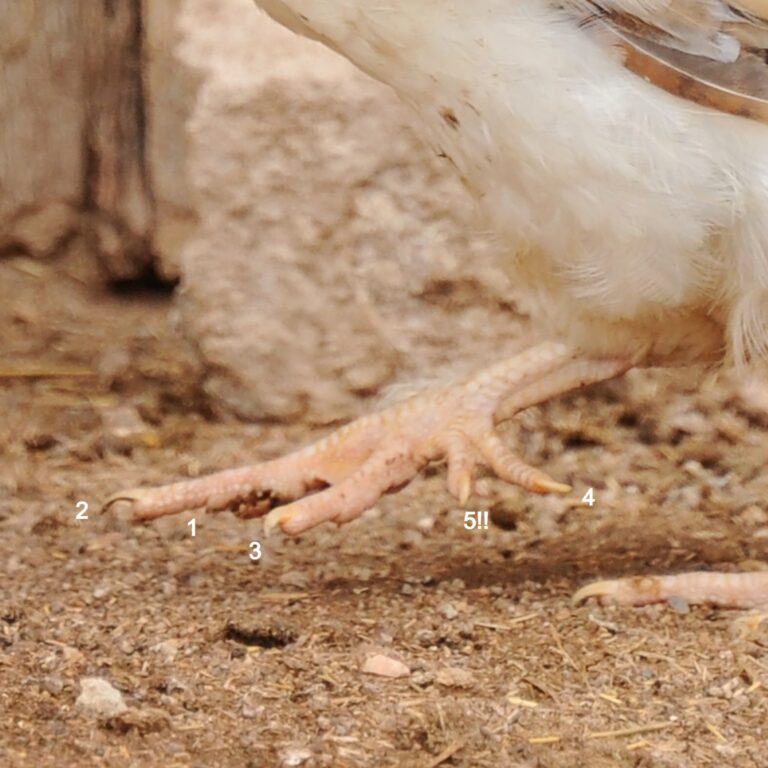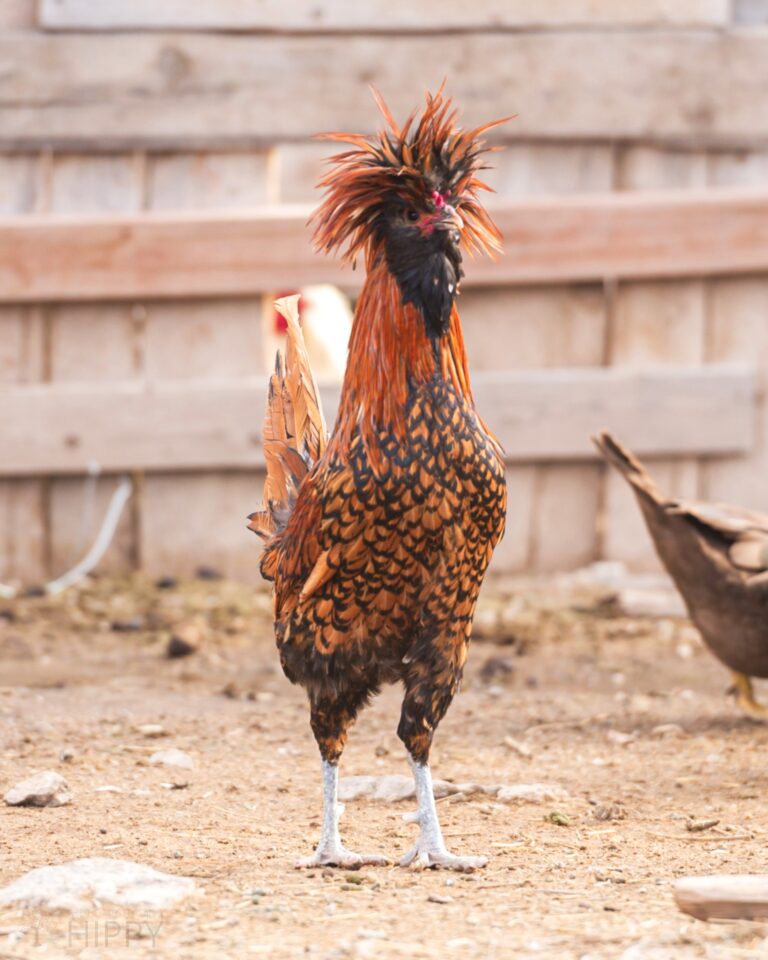If you’re a chicken keeper, it pays to get acquainted with your birds. You need to know what normal looks like so you can spot abnormalities when it comes to health, behavior, and also their physiology. Birth defects and mutations can happen in chickens just like any other animal, and though they aren’t always cause for alarm, sometimes you might need to cull a bird that is too far off the baseline.

When assessing our birds, let’s start at the feet. How many toes are normal for a chicken to have, and how many is considered too many?
Most chickens have four toes on each foot, though a few breeds will have five as standard. Having an extra toe is a condition known as polydactyly, and is rarely harmful or cause for alarm. Sometimes an extra toe can be an impediment to a chicken, however.
As a rule of thumb, your chickens should have four toes on each foot, though if you have one of the breeds we will discuss below you should expect them to have five toes as standard.
Knowing this, giving a quick glance at the feet of a chicken can help inform your assessment of what breeds you’re dealing with. If you see five toes, you really narrow it down, or else are dealing with an individual bird that has a mutation.
There’s a surprising amount of info that you’ll need to know concerning a chicken’s feet, so keep reading…
How Many Toes Do Chickens Typically Have?
Four. Four is the standard number of toes that you can expect any average chicken to have. Specifically, four toes on each foot, for eight toes total.
However, as we will learn, not all chickens fit this baseline, but that’s not necessarily a bad thing.
What’s the Usual Arrangement of the Toes?
Typically, a chicken will have three toes pointing forward in a sort of trident arrangement and one pointing to the rear, with this rearmost toe sometimes being called the claw.
This arrangement of the foot and toes allows chickens to have good balance on any surface and also grip roosting bars, mates, food, and any other surface with good dexterity.
Which Breeds Have Five Toes?
There are a few chicken breeds that have five toes as standard, and they are specifically the Faverolles, Houdan, Sultan, Silkie, and Dorking. This condition, known as polydactyly, simply means that a chicken or any other animal has extra toes on its foot.
In these birds, the additional digit typically grows on the front or slightly to the side of the foot and often out of the “base” where one of the other toes connects to it.
And, luckily, these extra digits are no bother whatsoever to the birds that have them, and they are indeed considered a hallmark of the respective breeds.
If the above chickens are missing this trademark extra toe, they might be considered defective by breed standards, although that varies depending on the governing poultry body or agency in question.
Do All Breeds Always Have the Same Number of Toes?
Yes, or rather they are expected to. However, sometimes you’ll encounter instances of polydactyly in chickens that nominally are supposed to have only four toes. Like I said above, mutations and genetic defects do occur and sometimes can reoccur in a given lineage.
We won’t delve too deeply into the science of why this is, but for your purposes, all you need to know is that you should base what is normal for your birds off of the breed standard.
If you don’t have a Dorking, Sultan, Faverolle, Houdan, or Silkie (or a hybrid bird) they should only have four toes. If they have an extra on one or both feet, that’s to be considered an abnormality.
Is an Extra Toe or Two a Problem?
It depends. For breeds that normally have five toes, the extra digit is not a problem at all, and they can still do all of the things that chickens normally do, including perching, walking, jumping, gripping mates, and so forth.
However, if a chicken is suffering from a mutation or birth defect where it has an extra toe, fully or partially formed, on one or both feet it might interfere with walking and standing. It all just depends, and you’ll have to assess that on a case-by-case basis for birds that are so afflicted.

How Many Toes Does a Rooster Have?
Roosters will have four toes on each foot as a standard, with the above five-toed breeds having five as expected.
Note that roosters typically have prominent spurs that they use for fighting and self-defense projecting from the back of their leg, though they’re located higher than the rearmost toe. These pointy spikes should not be mistaken for a toe, however.
How Many Toes Do Hens Have?
Once again, hens will have four toes on each foot as standard, and five-toed breeds will have five.
My Chicken Seems to Have a Thick or Partially Formed Toe…
When polydactyly occurs, especially in breeds where four toes is the standard, the extra digit might not be fully and separately formed.
You might notice what appears to be a small growth or bumpy protrusion originating from the foot or from another toe, or see that your chicken has a particularly thick, enlarged toe.
Both of these are instances of incomplete formation of the extra digit, with it either failing to grow to a typical length as expected in the case of the former, or essentially merging with another toe in the case of the latter.
If the extra digit merges with an existing toe, it might look like your chicken has the normal number of toes only, only with one that is noticeably thicker and bulkier than the others.
Though you technically might be able to get away with saying your chicken has the normal amount of toes, this is still considered a typical case of polydactyly.
Should You Have an Extra Toe Removed from Your Chicken?
As a rule, no. Most chickens that have an extra toe on one or both feet are not unduly hampered by it and can live a normal life for the most part.
Even if the affected bird does not have the extra toes according to the breed standard, you should not surgically intervene or attempt to remove it yourself out of mere vanity: things can always go wrong, and any kind of surgical operation will cause the bird pain and result in a greatly increased risk of infection.
If a chicken has a foot that is deformed badly enough to interfere with its walking and perching, you might consider culling, but outside of these circumstances there’s usually nothing to do.
Tim is a farm boy with vast experience on homesteads, and with survival and prepping. He lives a self-reliant lifestyle along with his aging mother in a quiet and very conservative little town in Ohio. He teaches folks about security, prepping and self-sufficiency not just through his witty writing, but also in person.
Find out more about Tim and the rest of the crew here.
